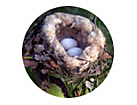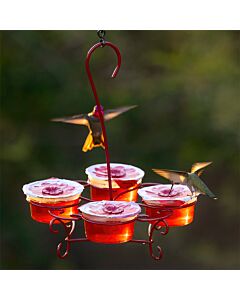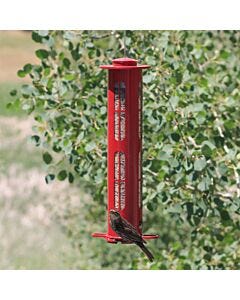RUBY-THROATED HUMMINGBIRD
BIRD LIBRARY »
Courtship habits of the Ruby-Throated Hummingbird
Each spring, the male Ruby-throated hummingbird is the first to arrive in a nesting area. This provides him time to stake out territory for feeding. While generally allowing females in his feeding territory, he will drive off competing males. Doing so allows him to focus his efforts on courtship.

In an effort to court females in his territory, a male Ruby-throated hummingbird will perform U-shaped diving displays, rising up to 50 feet above the female and swooping down. If the display attracts a female Ruby-throated hummingbird, she will perch nearby and continue to judge her potential suitor. If the female Ruby-Throated hummingbird ultimately likes what she sees, she indicates her willingness to mate.
Nesting habits of the Ruby-throated Hummingbird
Once mating is complete, the male moves on while the female begins nest-building in earnest. Unlike some other birds, the duties of creating the nest, incubation and feeding the chicks are entirely up to the female Ruby-throated Hummingbird.
The Ruby-throated Hummingbird nest is typically constructed of spider silk and plant materials. The silk is especially important since it allows the nest to expand as soon-to-be-hatched chicks grow. Once the shape of the nest is set, the female camouflages it with lichen and other plant items. Nests are normally located 10 to 40 feet above the ground on a downward sloping tree branch, usually in a deciduous tree. The nests can take up to 10 days to complete.
In the southern U.S., female Ruby-throated Hummingbirds can have up to three broods per year. In the northern U.S. and Canada, there’s only enough time to raise one brood before seasonal changes hit and the birds begin to migrate.
Ruby-throated Hummingbird Chicks
Except in rare circumstances, Ruby-throated Hummingbirds will lay two eggs, which hatch about two weeks later. The mother then feeds her chicks with small, protein-rich insects and nectar throughout the day. As the chicks grow, their nest expands with them – all thanks to the elasticity of the nest’s construction materials.
Ruby-throated Hummingbird chicks spend a good deal of their time stretching and “buzzing” their wings while sitting in the nest – these exercises are meant to strengthen their flight muscles.
Chicks remain in the nest about three weeks before taking their earliest test flights and then venturing into the world on their own.
Perkypet.com is the top destination to find quality Wild Bird Feeders and Accessories. Perky-Pet® and K-Feeders wild bird products are trusted brands to bird lovers everywhere. Interact with nature, relax and build memories that last a lifetime by conveniently ordering from perkypet.com. Happy Bird Feeding!








